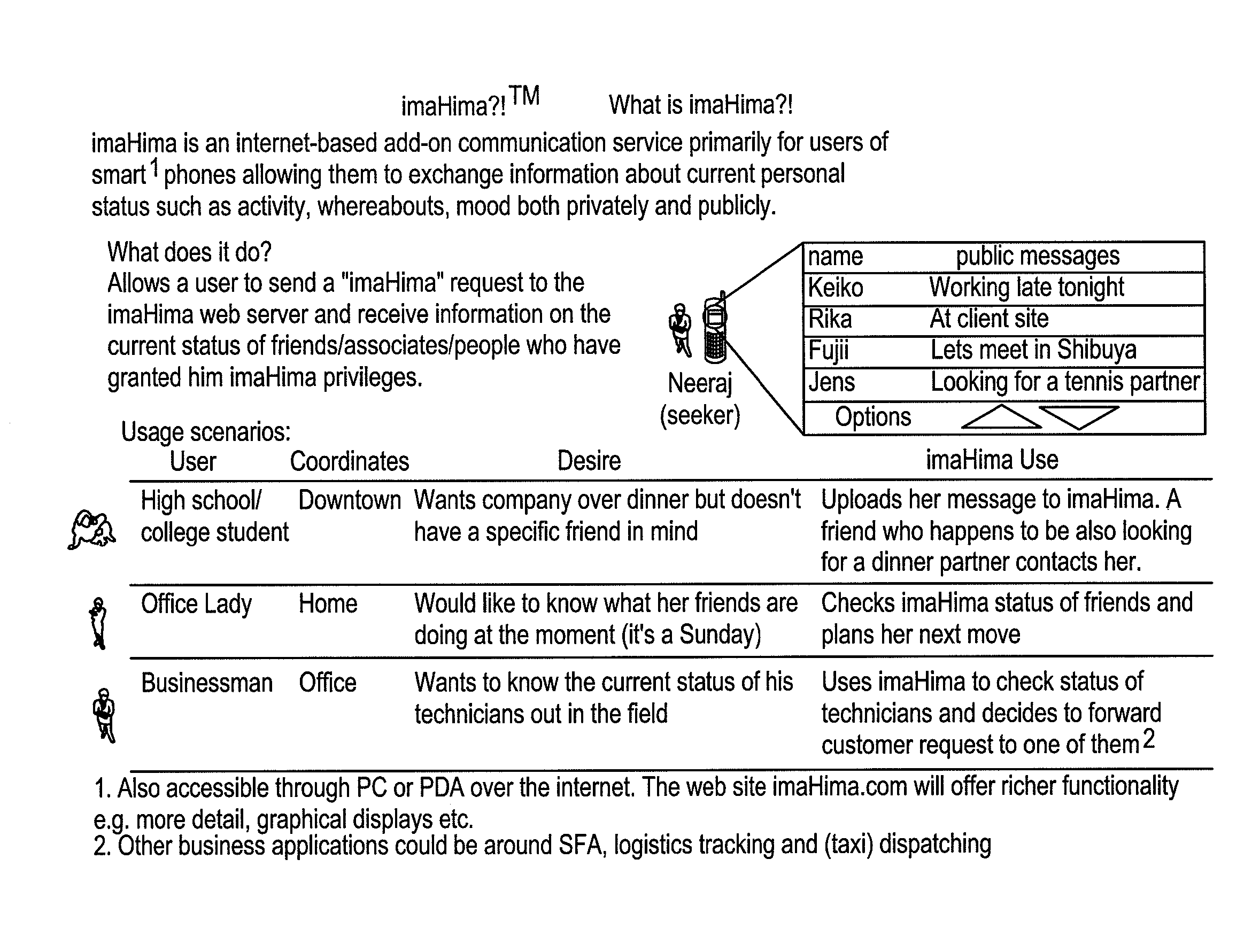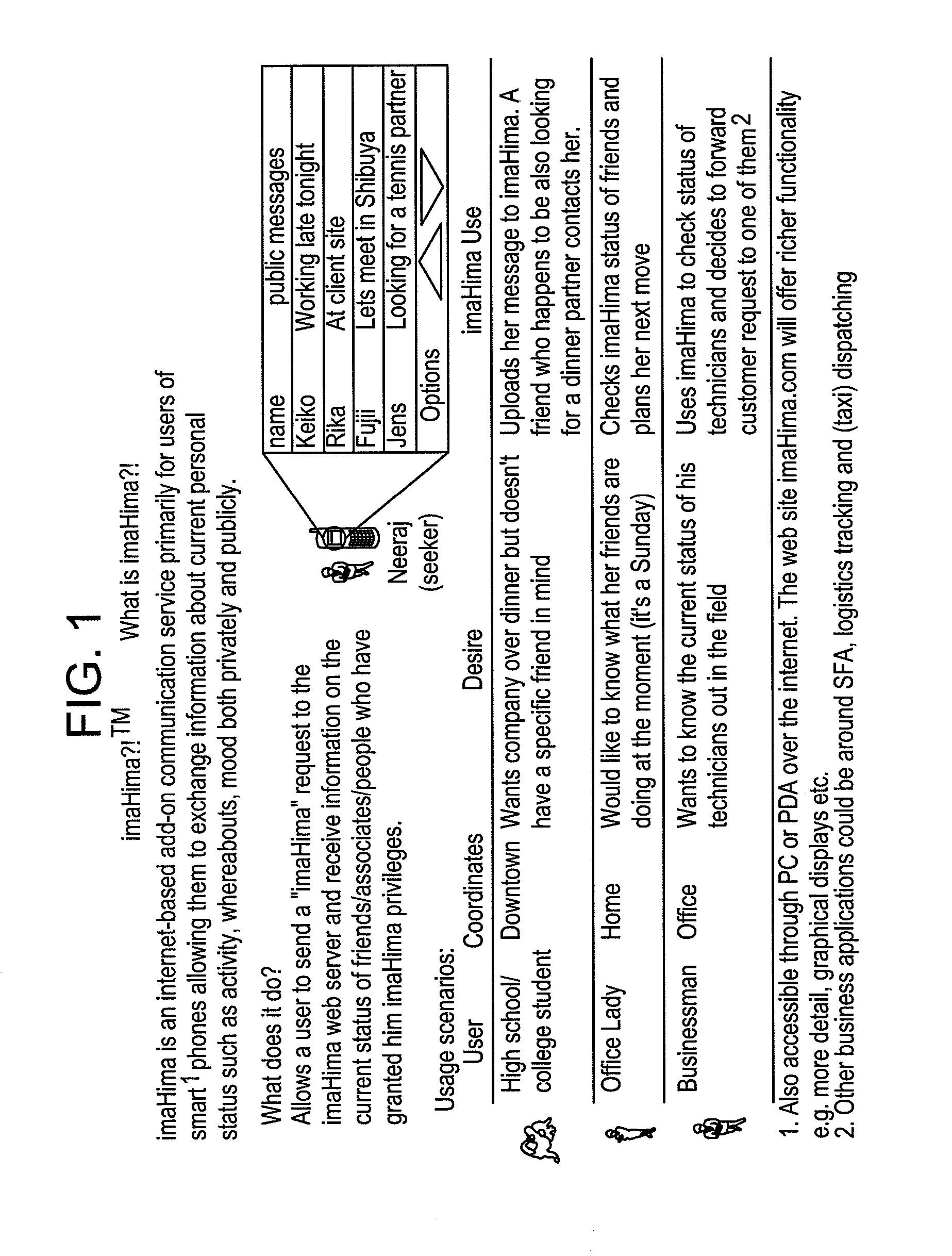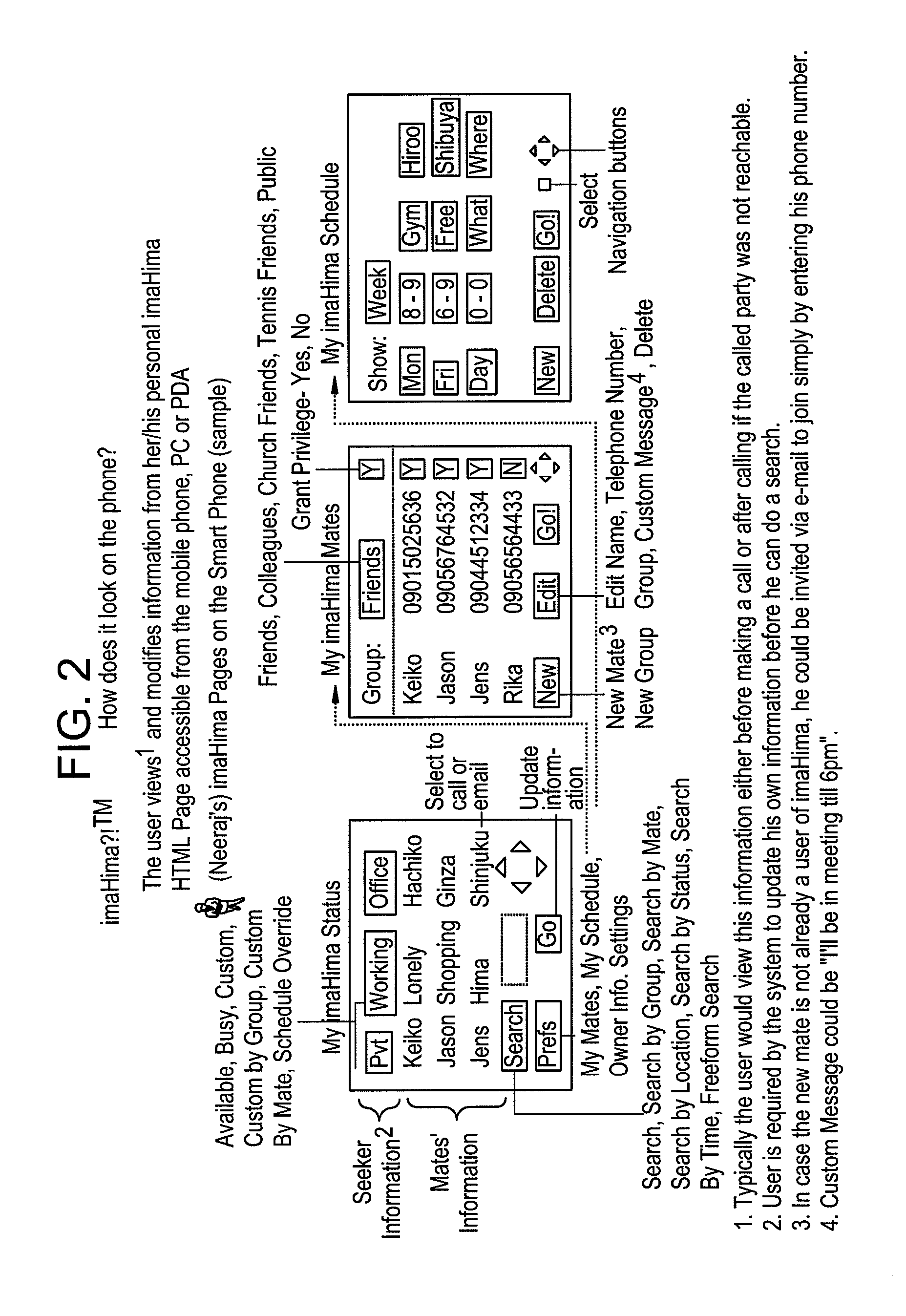As the
wireless mobile Internet area is in its infancy and market penetration has been rather low, much of the current attention is directed toward issues involved in achieving an acceptable,
data transmission rate,
data security, and reliability via the
wireless medium and in bringing desktop-type applications, which the users have long enjoyed on their desktop terminals, to the small screen of the typical
mobile device.
In contrast, deskbound users, because of the lack of mobility of their
Internet access, are typically restricted to accessing the Internet only when at home, in the office, or at a location where
Internet access through a desktop terminal may be found.
However, even if emails become widely accessible by mobile
Internet users, there are drawbacks to using emails for mobile user coordination purposes.
However, this manner of use is incompatible with mobile user coordination of events that are location-dependent and are perishable with the passage of time.
This is particularly disadvantageous to
mobile phone users who may wish to be notified with an audible warning (such as a ring) as soon as an email arrives.
Furthermore, email communication is intrusive in that it presumes that the recipients wish to receive and review the information sent by the senders.
In fact, most
Internet users nowadays are deluged with emails, most of them may even be well-intentioned, all of which require an undue amount of time every day to review and respond.
Again, this manner of use is also incompatible with the needs of mobile user coordination pertaining to events which may be location-specific and time-sensitive.
Furthermore, unless a user sends out an email or responds to one, email communication does not allow others to query for one's availability, current location,
mood, intended activity, location in the future, etc. without being intrusive.
By way of example, a user cannot readily inquire about the current location or availability of another user without sending an email and requesting a reply or in some manner require a response from the other user, who may be busy or simply uninterested in the reason for the inquiry.
Additionally, email content tends to be free-form and is thus difficult for merchants to easily utilize the information contained therein for the purpose of determining the user's location, present and intended activity, and the like.
Since such information is of great interest to merchants, the difficulty of ascertaining such information from free-form email communication is a drawback.
Additionally, the free-form nature of email also renders it less convenient as a communication tool for mobile
Internet users.
This is because most mobile Internet users loath to enter free-form data on the miniaturized keyboard /
handwriting recognition pad that are furnished with most mobile Internet devices today.
However, there are drawbacks to such a proposal.
For one, GPS tracking seriously threatens the privacy of the user of the GPS-enabled
mobile Internet device since it renders it possible to track the user at every instant.
For most users, this is the equivalent of being followed throughout the day and is simply an unwelcomed intrusion.
The integration of GPS technology into mobile Internet devices also involves additional power requirement, complex circuitries and costs, both for the mobile Internet devices and for the transmission networks that
handle them.
As the majority of mobile Internet devices, as well as their support infrastructures, are not GPS-enabled today, it is also not possible to offer services based on GPS technology until a sufficient number of users and service providers have upgraded their equipment to work with GPS.
Still furthermore, although location-finding technologies such as GPS can track a given user's current location, no information is available about that user's current activity, future activity, intended future location at a specified time, and / or availability / willingness to participate.
The available group calendar products are, for the most part, ill adapted for use via the Internet wherein the number and identity of users may not be known in advance and wherein the range of activities proposed may be infinite.
By way of example, most group calendar programs are not well adapted for allowing previously unknown users to sign on and perform searches and for allowing the users to control the privacy settings for individual items of information about themselves.
As another example, group calendars tend to work by posting information on calendars of others, a paradigm that is unsuitable when the size of the group that a user wishes to
gain expose to may be as large as the Internet
community itself.
In fact, most group calendars become unmanageable when the size of the group become too large and the sheer volume of calendared events overwhelm most users (giving rise to a problem not unlike the spam email problem).
This paradigm also tends not to work well on the miniaturized screens of most mobile Internet devices, which render it difficult to view a large amount of displayed data.
Additionally, because calendar products tend to be employed by users to plan their day and activities, the majority of which involve private activities and typically do not include other users, most of the entries therein are inapplicable for use in mobile user coordination applications (which, by design, are directed toward sharing information among mobile users).
Also, daily calendar information (versus posted information designed to invite participation by others) is typically considered highly private by most users, and a user tend to be reluctant to disclose such information to others (which partly explains the relative lack of use of such products nowadays and where they are used, only for work-related purposes and work-related entries among small, known group of people).
Because most people tend to associate a greater degree of privacy with their calendar entries, using calendar information for the purpose for promoting goods and services by merchants may provoke an unduly
negative reaction among users.
However, such a solution tends to be impractical as users typically do not want to have to keep track of which calendar to use for which purpose since the goal of using a calendar, after all, is to centralize information in one location for the purpose of planning one's day.
Furthermore, most group calendar products are not well adapted to the needs of mobile Internet users, who inherent characteristics is constantly changing location.
Furthermore, most group calendar products also involve
unstructured data entry, which tends to be less attractive for mobile Internet users who, as mentioned earlier, have to contend with the limited
screen space and keyboard /
handwriting recognition pad of their mobile Internet devices.
Still further, the group calendar products currently available, being developed for desktop computers, tend to require a large amount of memory, permanent storage, and
processing power to run.
Permanent and
random access memory, as well as computing power and battery life, are of course
limited resources on mobile Internet devices, thus rendering the
current generation of group calendar products unsuitable for use on the mobile Internet devices.
Instant messaging, which is a technology developed when
Internet access was primarily accomplished via desktop terminals, also suffer many of the same deficiencies.
However,
instant messaging as it is currently implemented does not account for the mobile nature of users (as would be the case when users access the Internet wirelessly via mobile Internet devices) or the time-dependent nature of the activities involved.
For example, there is no established facility within
instant messaging to allow users to invite others to a planned activity happening at some predefined time in the future at some predefined location (or allow others to search for the same).
Instant messaging applications also require downloading
executable codes, a requirement that is typically unwelcomed by users of the mobile Internet devices who are constantly challenged with doing more with less
power consumption, and less computing and memory resources.
Because of these shortcomings, these technologies, which were developed when desktop Internet access were the predominant mode of access, do not adequately serve the needs of the mobile Internet users.
As front-ends for electronic commerce applications, they also have many deficiencies.
 Login to View More
Login to View More  Login to View More
Login to View More 


